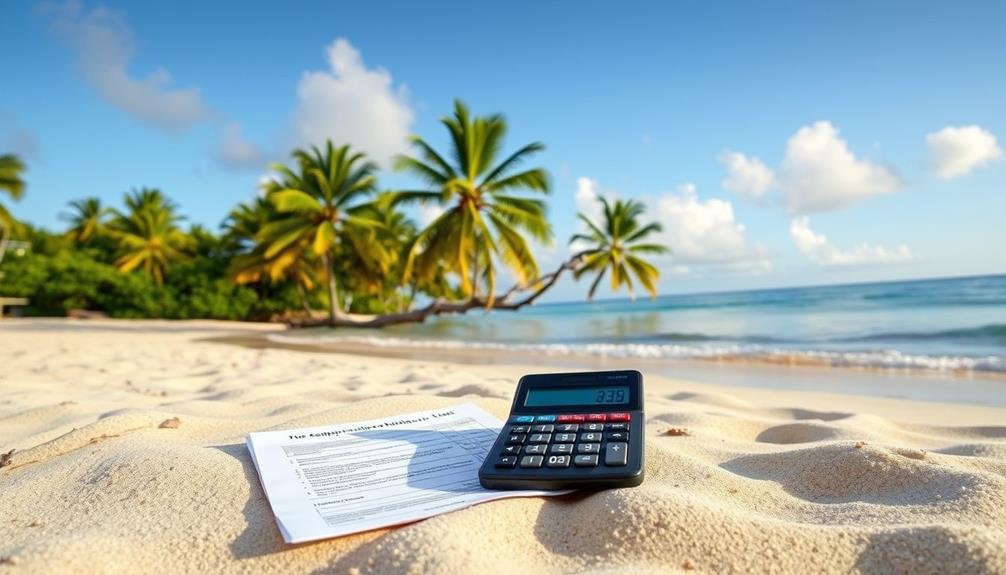Retirement planning in Hawaii provides unique advantages, particularly through the Hawaii Retirement Savings Program (HRSP). This program enrolls you automatically in a Roth IRA, allowing for tax-free withdrawals during retirement. With a default contribution rate of 5%, your savings have the potential to grow significantly. Additionally, by consistently contributing for 12 months, you may be eligible for a state matching contribution of up to $500. While your employer handles contributions, you have direct control over your savings. There is a plethora of information to discover regarding how these choices can improve your retirement strategy in Hawaii.
Key Takeaways
- Hawaii's Retirement Savings Program (HRSP) automatically enrolls private sector employees into Roth IRAs, enhancing retirement savings for those without employer-sponsored plans.
- Roth IRAs allow tax-free withdrawals in retirement, and contributions can be accessed anytime without penalties, offering flexibility for savers.
- Employees can benefit from a state matching contribution of up to $500 after 12 months of consistent contributions to their Roth IRA.
- Employers must ensure compliance by managing payroll deductions and informing employees about HRSP enrollment and contribution processes.
- The HRSP aims to reduce the retirement savings gap in Hawaii, promoting financial security and potentially lowering poverty rates among seniors.
Overview of Hawaii's Retirement Savings Program

Starting July 1, 2024, Hawaii's Retirement Savings Program (HRSP) will provide a valuable option for private sector employees who lack employer-sponsored retirement plans.
This state-sponsored retirement plan aims to enhance employees' retirement savings by establishing a Roth IRA for each enrolled participant. You'll automatically be enrolled, with a default contribution rate of 5% of your salary, though you can adjust this amount to fit your financial goals.
Employers are responsible for managing payroll deductions, ensuring the process is seamless for you. If your employer fails to enroll you, they could face penalties ranging from $25 to $50 per month for each unenrolled employee.
Additionally, to encourage long-term participation, the state offers matching contributions of up to $500 for the first 50,000 participants who remain enrolled for at least 12 consecutive months. This incentive can greatly boost your retirement savings.
The HRSP represents a proactive approach to retirement planning in Hawaii, enabling you to build a secure financial future even if your employer doesn't offer a traditional retirement plan.
Key Features of Roth IRAs

A Roth IRA offers several key advantages that make it an attractive retirement savings option. One of the most significant benefits is that your contributions are made with after-tax dollars, which means your withdrawals in retirement can be entirely tax-free, as long as you meet certain conditions. This feature allows your retirement savings to grow without the burden of taxes eating into your funds.
Additionally, earnings in a Roth IRA grow tax-free, enhancing your overall accumulation compared to traditional retirement accounts.
You also gain substantial flexibility with a Roth IRA. Unlike traditional IRAs, there are no required minimum distributions (RMDs) during your lifetime, allowing you to strategize your withdrawals based on your financial needs.
Moreover, you can access your contributions at any time without penalties, making it a more accessible option for those who might need to tap into their funds before retirement.
This combination of tax-free growth, flexible access to contributions, and no RMDs guarantees that a Roth IRA can be a powerful tool in your retirement planning strategy, tailored to meet your unique financial goals.
Contribution Rates and Limits

When planning for retirement, understanding contribution rates and limits is essential for maximizing your savings potential. For the Hawaii Retirement Savings Program (HRSP), the default contribution amount deducted from employees' payroll is set at 5% of their compensation. However, you have the flexibility to adjust this percentage based on your financial goals.
In addition to the HRSP, you can also contribute to your Roth IRA. For 2024, the contribution limits are as follows:
| Account Type | Contribution Limits |
|---|---|
| Roth IRA (under 50) | Up to $7,000 |
| Roth IRA (50 and older) | Up to $8,000 (catch-up) |
| HRSP Default Rate | 5% of compensation |
| State Match | Up to $500 for eligible participants |
Contributions to the HRSP are deducted directly from payroll, ensuring you're consistently saving while adhering to IRS contribution limits. Remember, all contributions and earnings in the HRSP are owned by you, giving you full control over your retirement savings. This state-sponsored retirement plan is a powerful tool for securing your financial future in Hawaii.
State Matching Contributions

When you participate in the Hawaii Retirement Savings Program, you can take advantage of state matching contributions to boost your retirement savings.
To qualify, you need to actively contribute to your Roth IRA for 12 consecutive months and be among the first 50,000 employees who enroll.
Understanding the eligibility requirements and the matching process can help you maximize your savings potential.
Contribution Matching Process
Although you may be enthusiastic to grow your retirement savings, understanding the contribution matching process in Hawaii is essential for maximizing your benefits.
The Hawaii Retirement Savings Board offers a state match for employee contributions to the Hawaii Retirement Savings Plan (HRSP) that can greatly boost your savings. Here's how the matching process works:
- Contribution Requirement: You must consistently contribute to your Roth IRA through payroll deductions.
- Duration: To qualify for the match, you need to maintain uninterrupted participation in the program for 12 consecutive months.
- Matching Limit: The state matches your contributions up to $500, effectively doubling your savings potential.
- Enrollment Incentive: This matching contribution is available for the first 50,000 employees who enroll, so early participation is key.
Taking advantage of the state matching funds can greatly enhance your retirement savings strategy.
Eligibility Requirements Explained
To qualify for state matching contributions in Hawaii's Retirement Savings Program, you need to meet specific eligibility requirements. First, you must enroll in the program and consistently contribute for 12 consecutive months. The state matches employee contributions up to a maximum of $500, making it a powerful incentive for small business owners and employees alike. However, it is crucial to recognize that matching funds are limited to the first 50,000 employees who enroll.
Here's a quick breakdown of the key requirements:
| Requirement | Details |
|---|---|
| Enrollment | Must enroll in the state-sponsored plan. |
| Contribution Duration | Contribute for 12 consecutive months. |
| Contribution Rate Adjustment | Can adjust rates, but only 12-month contributions count. |
Maximizing Retirement Savings Potential
Maximizing your retirement savings potential in Hawaii involves taking full advantage of the state matching contributions available through the Hawaii Retirement Savings Program (HRSP).
By participating in the HRSP, you can greatly boost your retirement savings and enhance your financial security. Here's how to make the most of it:
- Contribute Consistently: Confirm you contribute at least 5% of your salary to qualify for state matching contributions.
- Enroll Early: The first 50,000 employees to join the HRSP can access up to $500 in matching funds after 12 months of participation.
- Utilize Roth IRAs: Remember, the annual contribution limit for Roth IRAs is $7,000 ($8,000 if you're 50 or older), allowing you to maximize your retirement savings.
- Plan for the Long Term: Focus on long-term savings to reap the benefits of compounding interest and state contributions.
Employer Compliance Responsibilities

How can employers in Hawaii guarantee they're meeting their compliance responsibilities regarding retirement savings?
First, you need to notify your employees about the state-facilitated retirement savings program. It's vital to automatically enroll those who don't already have a retirement plan. This step is essential to comply with the state retirement plan requirements.
Next, verify you're withholding employee contributions from their salaries and transmitting these contributions to the program by the 15th day of the following month. Remember, non-compliance can lead to penalties of $25 per month for each unenrolled employee, escalating to $50 for ongoing non-enrollment.
While the Hawaii Retirement Savings Board administers the program, you're still responsible for verifying compliance with enrollment and contribution requirements.
You won't be liable for the plan's administration, but you must keep a close eye on the contribution limits set by the Internal Revenue Code. Overstepping these limits can jeopardize compliance, so it's important to educate your employees and monitor their contributions diligently.
Benefits for Small Businesses

Offering retirement savings options through state-sponsored programs like the Hawaii Retirement Savings Program (HRSP) can greatly benefit small businesses. By participating, you can enhance employee satisfaction and retention while simplifying your administrative responsibilities.
Here are some key advantages:
- Automatic Enrollment: HRSP automatically enrolls employees without other retirement options, ensuring they start saving right away.
- Payroll Deduction Contributions: Employees can easily contribute via payroll deductions, with a default rate of 5% of their salary, making retirement savings straightforward.
- Incentives for Participation: The state matches contributions up to $500 for employees who stay enrolled for 12 months, encouraging long-term commitment to retirement savings.
- Attracting Talent: Offering a state-mandated retirement plan like HRSP can help small businesses attract top talent by providing competitive benefits.
Alternative Retirement Options

If you're exploring alternative retirement options, consider the benefits of a Roth IRA, which offers tax-free growth and withdrawals in retirement.
Additionally, some states provide matching contributions that can boost your savings even more.
Moreover, you might want to explore the potential of rolling over your 401k into a Gold IRA for diversification and protection against market downturns diversification of retirement portfolio.
These options can help you secure a more comfortable financial future in Hawaii.
Roth IRA Benefits
Roth IRAs provide a flexible and tax-efficient way to save for retirement, making them an attractive option for many individuals. By contributing after-tax dollars, you can enjoy significant tax advantages when it's time to withdraw your funds.
Here are some key benefits of Roth IRAs:
- Tax-Free Withdrawals: Qualified withdrawals in retirement are completely tax-free, allowing you to keep more of your money.
- Higher Contribution Limits: In 2024, you can contribute up to $7,000, or $8,000 if you're age 50 or older, maximizing your retirement savings.
- Flexible Access: You can withdraw your contributions at any time without penalties or taxes, which provides peace of mind if you need access to funds before retirement.
- Automatic Enrollment: The Hawaii Retirement Savings Program (HRSP) facilitates Roth IRAs through automatic payroll deductions, making saving easier.
State Matching Contributions
Hawaii's retirement landscape offers more than just Roth IRAs; the Hawaii Retirement Savings Program (HRSP) introduces state matching contributions to boost your savings. If you're one of the first 50,000 employees to enroll, you can receive up to $500 in matching funds after participating for 12 consecutive months. This initiative enhances your retirement savings potential and promotes financial security for those who might otherwise struggle.
By adjusting your contribution rate from the default 5% of your salary, you can maximize the state match and grow your overall retirement savings. The contributions you make through the HRSP go directly into Roth IRA accounts, allowing for tax-free withdrawals during retirement. This combination of state matching contributions and the Roth IRA's tax benefits creates a powerful strategy to close the retirement savings gap in Hawaii.
With approximately 216,000 workers lacking employer-sponsored retirement plans, the HRSP encourages employee participation to guarantee a more secure financial future. By taking advantage of these state-specific benefits, you're not just investing in your retirement; you're also contributing to a broader movement toward enhanced financial wellness in Hawaii.
Long-Term Economic Implications

Recognizing the potential impact of the Hawaii Retirement Savings Program (HRSP), the state is poised to see significant long-term economic benefits. By enhancing retirement savings for around 216,000 workers who currently lack employer-sponsored plans, the HRSP could reshape Hawaii's financial landscape.
Here are some key implications:
- Reduced Reliance on State Assistance: As workers save for retirement, there will be less pressure on state-funded programs.
- Increased Financial Security: Automatic enrollment and state matching contributions will bolster the financial stability of Hawaii's workforce.
- Stimulated Economic Growth: Higher retirement savings can lead to increased consumer spending, benefiting local businesses.
- Tax-Free Income: The emphasis on Roth IRAs allows for tax-free withdrawals, providing retirees with more disposable income.
As these changes take shape, you'll likely notice a decrease in poverty rates among seniors.
This alleviation of long-term pressures on state resources sets a precedent that may influence national retirement policy. Ultimately, the HRSP could serve as a model for similar initiatives across the U.S., addressing the retirement savings gap and fostering a more secure economic future for all in Hawaii.
Navigating Retirement Planning Resources

As the Hawaii Retirement Savings Program (HRSP) sets the stage for enhanced financial security, it's important to know how to make the most of the resources available to you.
The HRSP allows employees without employer-sponsored plans to set up Roth IRAs through convenient payroll deductions. This means you can effortlessly boost your retirement savings.
You have the option to contribute a default of 5% of your compensation, which you can adjust up to the IRS limit of $7,000 annually, or $8,000 if you're over 50. Plus, the state incentivizes your commitment by matching employee contributions up to $500, provided you maintain participation for 12 consecutive months.
Employers are required to automatically enroll eligible employees in the HRSP, with penalties for non-compliance to encourage prompt participation.
To further assist you in maneuvering through this process, take advantage of the financial workshops and calculators offered by the Employees' Retirement System (ERS). These tools help clarify your benefits under the HRSP and guide you in maximizing your retirement savings.
Frequently Asked Questions
What Is the Hawaii State Sponsored Retirement Plan?
The Hawaii State Sponsored Retirement Plan, called Hawaii Saves, automatically enrolls you in a payroll deduction system, helping you save for retirement. You can adjust contributions, and the state offers matching funds to boost your savings.
How Is Hawaii State Retirement Calculated?
Imagine you've worked in Hawaii for 30 years. Your retirement benefit's calculated by taking your highest average salary over five years, multiplying it by 60%, and adjusting for cost-of-living increases to maintain your purchasing power.
What Is the Hawaii Saves Program?
The Hawaii Saves Program lets you save for retirement through payroll deductions, automatically enrolling you in a Roth IRA. You'll enjoy a state match up to $500 if you maintain participation for a year.
How Many Years Do You Have to Work for the State of Hawaii to Retire?
To retire from state service in Hawaii, you need at least five years of credited service. If you have 30 years of service, you can retire at any age, regardless of your current age.
Conclusion
In Hawaii, your retirement planning can be as vibrant as a sunset over the Pacific. By integrating IRAs with state-specific benefits, you can maximize your savings and enjoy the golden years you've dreamed of. Don't forget to explore alternative options and take advantage of the resources available to you. With a little effort, you'll pave a smooth path to financial security, ensuring your future shines bright like the sun dipping below the horizon.
Helen brings a wealth of experience in investment strategy and a deep passion for helping individuals achieve their retirement goals. With a keen understanding of market dynamics, Helen has been instrumental in shaping the vision and direction of Gold IRA Markets. She specializes in creating innovative solutions that align with our clients’ long-term investment objectives.










